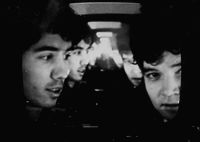|
We did a couple of such improvised continuous tape-long sessions,
in the summer of 1980, and took the resulting tapes to a 4-track
recording studio, where we selected ten extracts, of which we then
somewhat narrowed the extreme left-right instrument separation of
the original tape, to obtain a more middle-of-the-road stereo-image.
Also, to one or two of them, we added a slight touch of percussion
and some vocal sounds.
The series thus obtained we named 'Signs & Symptoms', after
the returning paragraph title in a guide to 'Survival
in the City' (written by Anthony Greenbank, edited by Wolfe
Publishing Limited, London, 1974), an amusingly curious book of
which both of us had a copy, and piles of which were to be had for
several years at one of the major Amsterdam used & remainders
book stores.
 |
 |
The 'Signs and Symptoms' were that what characterized each of the
sixty distinct types of 'Big City Losers', as described by Greenbank
in his guide: "those who are the most probable victims of mugging,
robbery, rape, mutilation, coshing, murder, burglary, pocket-picking,
street accidents or molestation by the pervert who picks on someone
to sit next to in the cinema".
'Frippertronics' often is associated with so-called 'ambient music',
as it does easily enable one to set in motion a quasi-automatic
process for creating slowly evolving timbres with minimal shifts
of accents within a steady stream of 'waves of sound' that, as Eno
writes in the liner notes to his 'Discreet
Music', can be listened to "as part of the ambience of the environment
just as the colour of the light and the sound of the rain [are]
parts of this environment".
But of course it doesn't need to be put to use in just that way.
Listening to 'Signs & Symptoms' you'll soon enough realize that
most of what you are hearing is far from being 'ambient'. Indeed,
it was not intended to be. At the time of recording we were hardly
interested in 'ambient' types of music, even less keen on producing
them.
We wanted to be heard. A lot.
And whereas an 'ambient' use of 'Frippertronics' aims at less,
by minimizing the performer's interference with 'the system', we
rather turned to the machines in order to get more, using
the feedback mechanism to, say, 'maximize' our output, and approach
that of a 'full blown instant band' ...
We made and distributed a (very) limited number of audio cassettes
containing the ten 'Signs & Symptoms'-tracks, with hand made
'covers', as shown in the picture.
Needless to say that 'Signs & Symptoms' has been 'unavailable'
ever since...
We therefore created, late 2002, for our archiving as much as for
your listening pleasure, a special 'Signs & Symptoms'-page
at mp3.com, which enabled you to stream tracks from the original
cassette-release, either in lo-fi (mono, 28Kbs) or in hi-fi (stereo,
128Kbs) real audio format. The complete series moreover was available
as an mp3.com-CD, with a brand new cover.
[Since at december 02, 2003, 'good old' mp3.com closed
down, this 're-release'
has become itself another 'collector's item'. You can
(as of february 2006), listen
to Signs & Symptoms at Last.fm ... A digital high quality
audio version of the album is (as of july 2010) available
from bandcamp. ]
thank yous || some links
° Thanks to Michael
Peters, who provided some of the details on the history of 'Frippertronics'
through his article 'The
Birth of Loop', available at 'Looper's
Delight', a web site dedicated to loop based music.
° A 2015 version of Michael's article on the history of looping in music, lavishly illustrated, on the 'Prepared Guitar' blog: The Birth of Loop by Michael Peters.
° Thanks also to Colin Robinson, of Big Block 454, a 'semi-amorphous
post-modern / situationist neo-dada cross-platform compositional
construct' from Manchester, England, for confirming some of the
technical details of doing 'Frippertronics' with Akai reel-to-reels,
wiping the dust of ages of off his old machines ("one with
faulty heads; the other with major wow-and-flutter"), asking
them to pose with him to show us 'how it looked like' and providing
details on his own adventures in 'Frippertronics'. ("I
used to have the two decks as far apart as possible, and also swapped
the stereo on the feedbacklink, so that each repeat swapped channels.
I would then touch the tape to get wild wow and flutter!")
[ edited 2003 : apr 06, nov 22 | edited 2005 : nov 15 | edited 2008
: jan 14 | edited 2009 : june 1 | edited 2010 : july 31 | edited 2015 : september 5]
|


